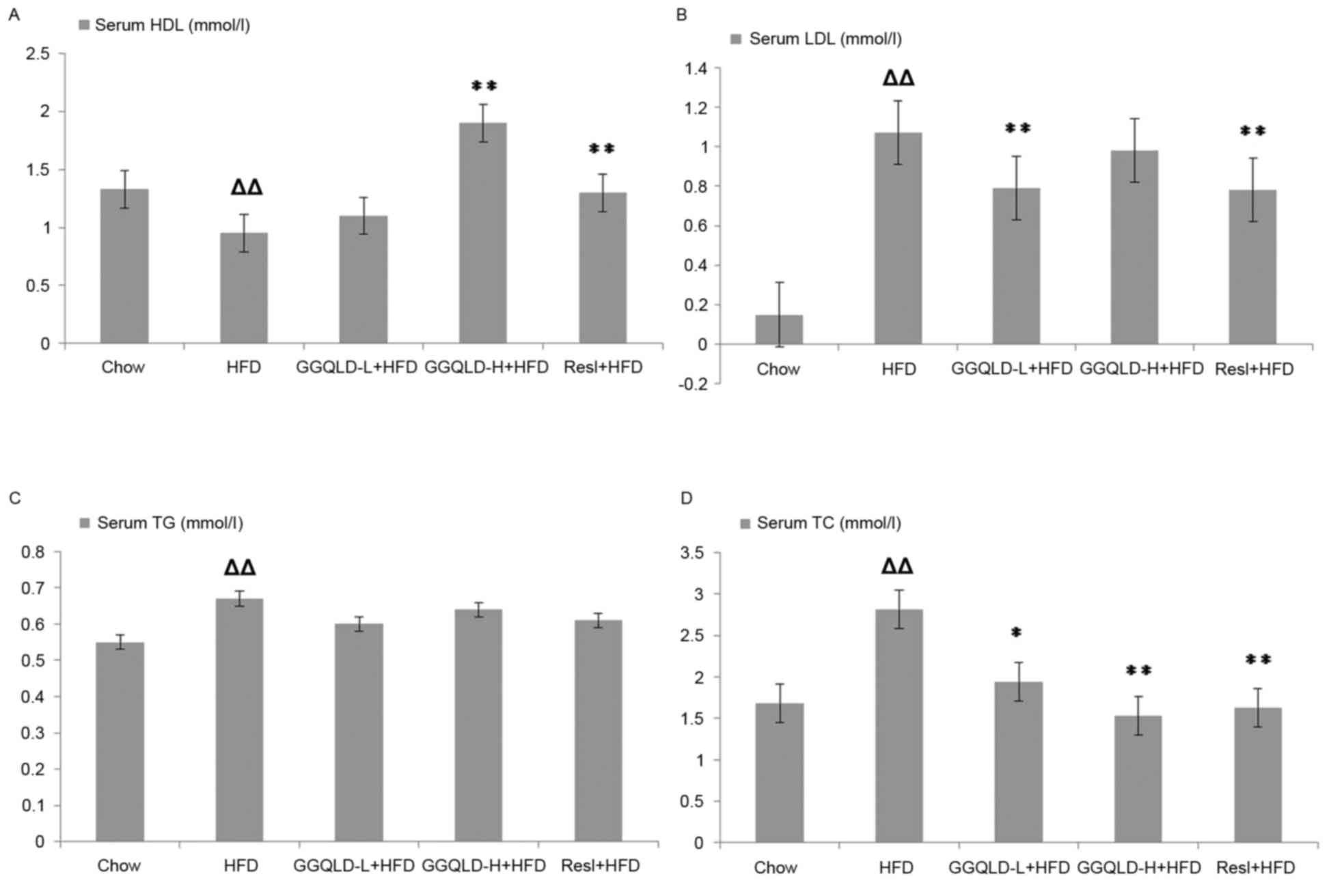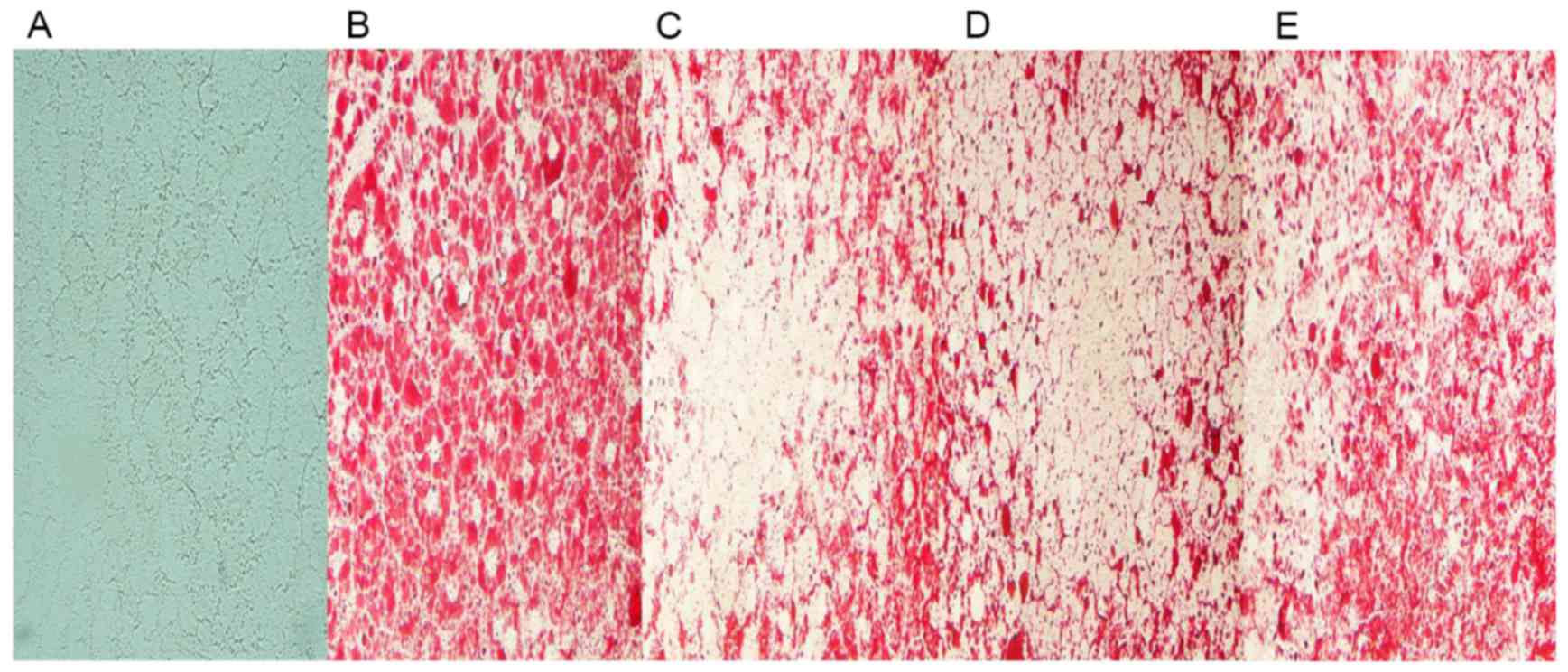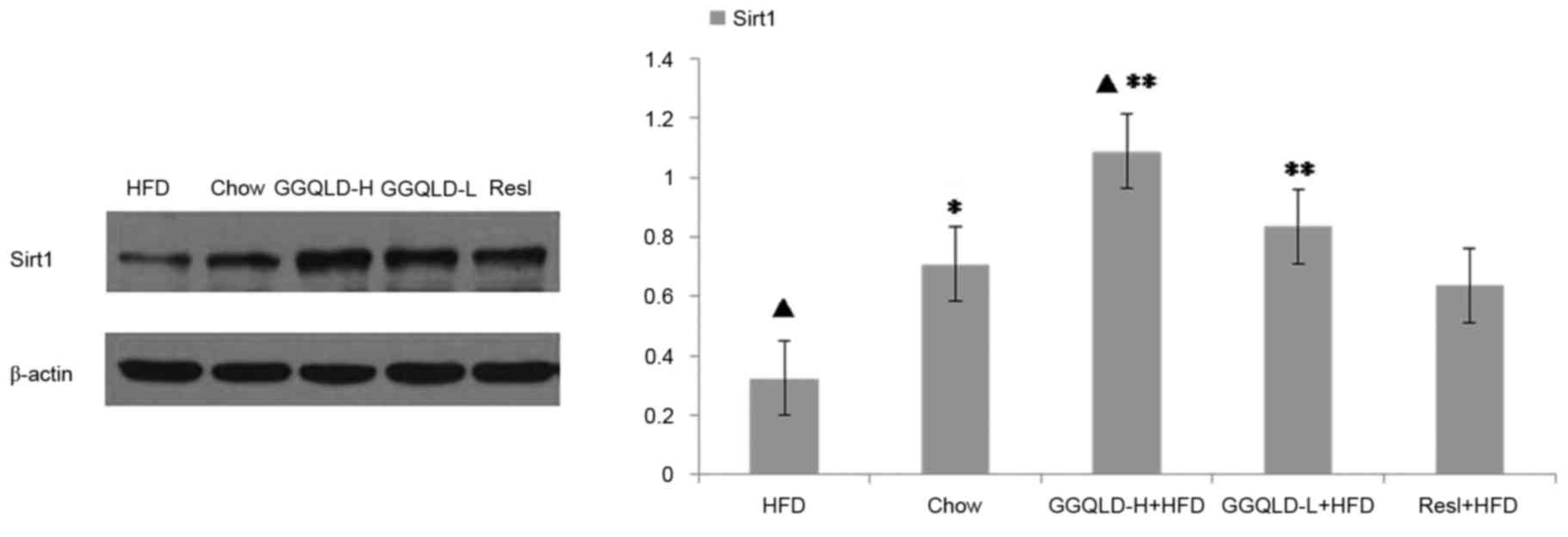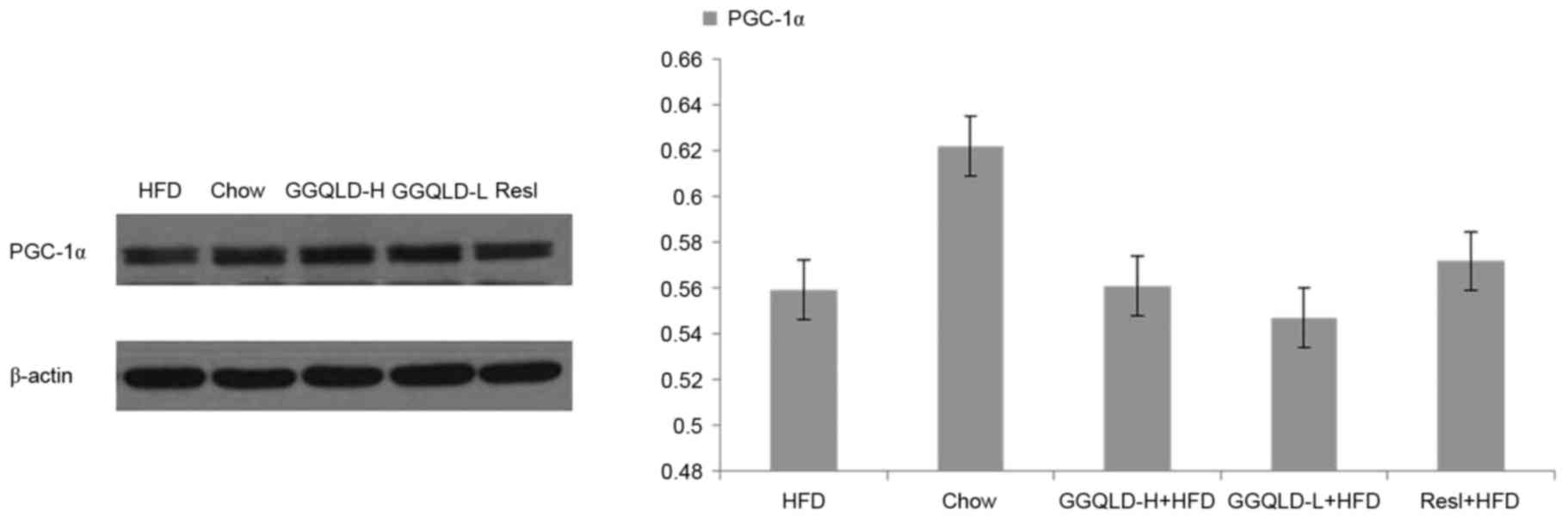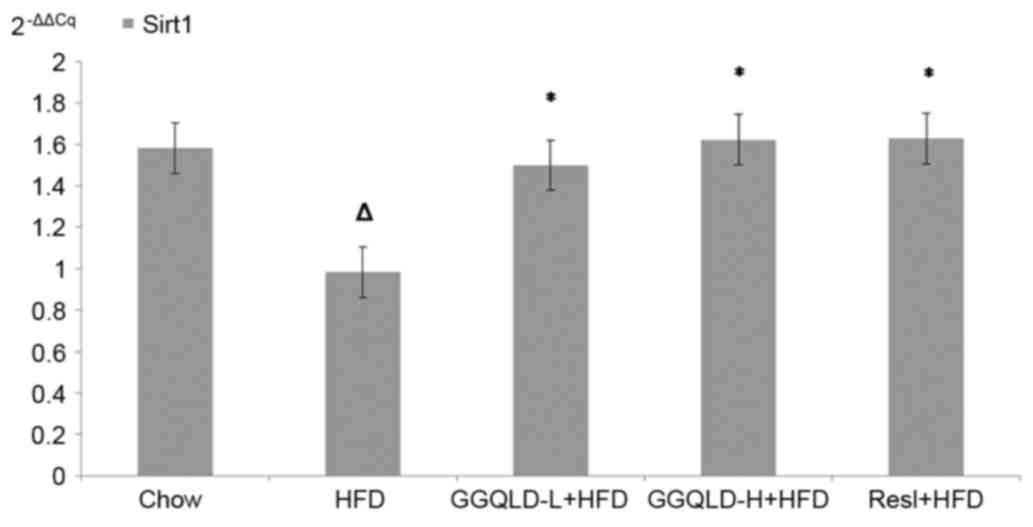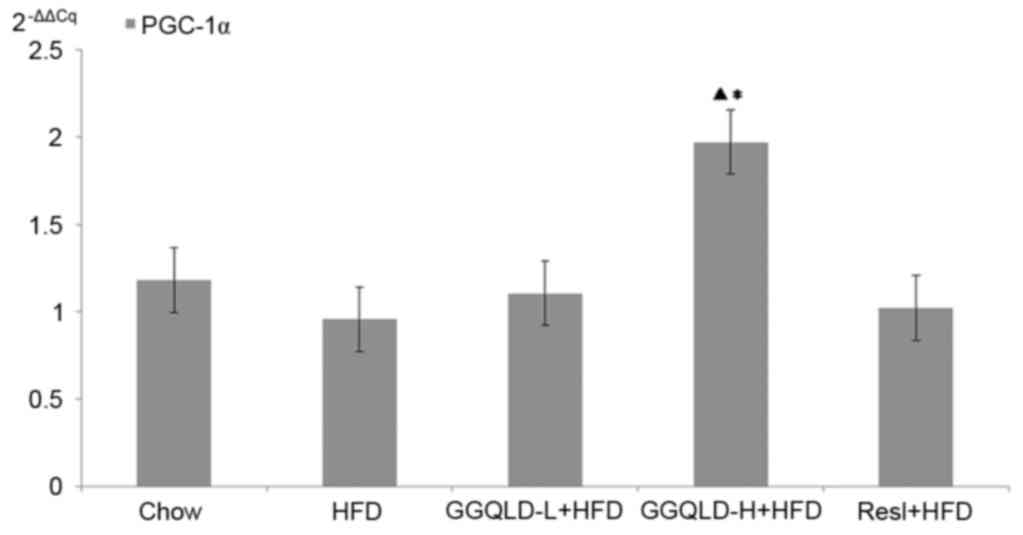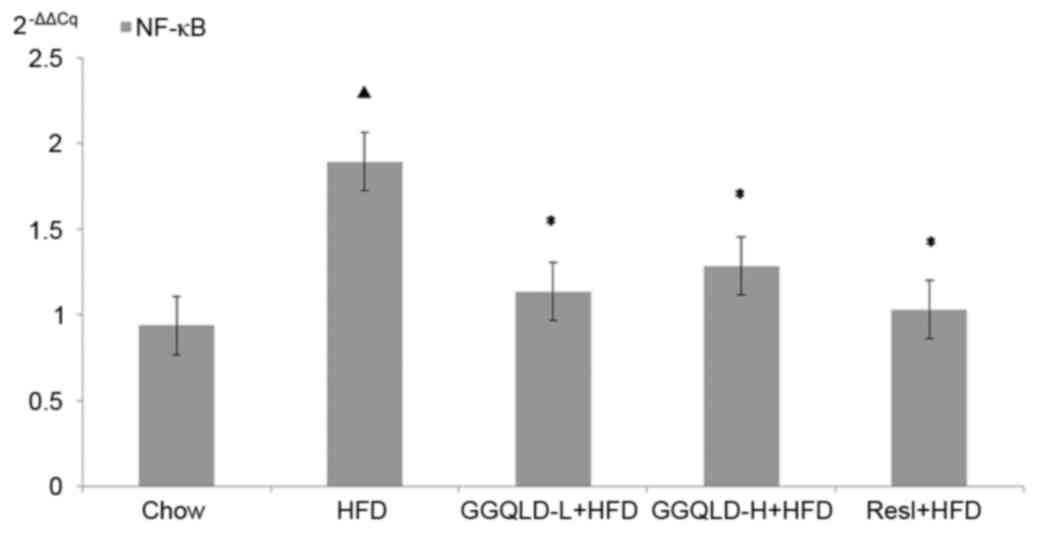|
1
|
Dowman JK, Tomlinson JW and Newsome PN:
Pathogenesis of non-alcoholic fatty liver disease. QJM. 103:71–83.
2010. View Article : Google Scholar : PubMed/NCBI
|
|
2
|
de Alwis NM and Day CP: Non-alcoholic
fatty liver disease: The mist gradually clears. J Hepatol.
48:S104–S112. 2008. View Article : Google Scholar : PubMed/NCBI
|
|
3
|
Clark JM and Diehl AM: Nonalcoholic fatty
liver disease: An underrecognized cause of cryptogenic cirrhosis.
JAMA. 289:3000–3004. 2003. View Article : Google Scholar : PubMed/NCBI
|
|
4
|
Enjoji M, Yasutake K, Kohjima M and
Nakamuta M: Nutrition and nonalcoholic Fatty liver disease: The
significance of cholesterol. Int J Hepatol. 2012:9258072012.
View Article : Google Scholar : PubMed/NCBI
|
|
5
|
Jou J, Choi SS and Diehl AM: Mechanisms of
disease progression in nonalcoholic fatty liver disease. Semin
Liver Dis. 28:370–379. 2008. View Article : Google Scholar : PubMed/NCBI
|
|
6
|
Postic C and Girard J: Contribution of de
novo fatty acid synthesis to hepatic steatosis and insulin
resistance: Lessons from genetically engineered mice. J Clin
Invest. 118:829–838. 2008. View
Article : Google Scholar : PubMed/NCBI
|
|
7
|
Kugelmas M, Hill DB, Vivian B, Marsano L
and McClain CJ: Cytokines and NASH: A pilot study of the effects of
lifestyle modification and vitamin E. Hepatology. 38:413–419. 2003.
View Article : Google Scholar : PubMed/NCBI
|
|
8
|
Zhao Y, Ling F, Griffin TM, He T, Towner
R, Ruan H and Sun XH: Up-regulation of the Sirtuin 1 (Sirt1) and
peroxisome proliferator-activated receptor γ coactivator-1α
(PGC-1α) genes in white adipose tissue of Id1 protein-deficient
mice: Implications in the protection against diet and age-induced
glucose intolerance. J Biol Chem. 289:29112–29122. 2014. View Article : Google Scholar : PubMed/NCBI
|
|
9
|
Xue CC, Zhang AL, Greenwood KM, Lin V and
Story DF: Traditional chinese medicine: An update on clinical
evidence. J Altern Complement Med. 16:301–312. 2010. View Article : Google Scholar : PubMed/NCBI
|
|
10
|
Shi Z, Li Z, Zhang S, Fu H and Zhang H:
Subzero-Temperature Liquid-Liquid Extraction Coupled with
UPLC-MS-MS for the simultaneous determination of 12 bioactive
components in traditional chinese medicine gegen-qinlian decoction.
J Chromatogr Sci. 53:1407–1413. 2015. View Article : Google Scholar : PubMed/NCBI
|
|
11
|
Ling X, Xiang Y, Tang Q, Chen F and Tan X:
Comparative pharmacokinetics of eight major bioactive components in
normal and bacterial diarrhea mini-pigs after oral administration
of Gegen Qinlian Decoction. J Chromatogr B Analyt Technol Biomed
Life Sci. 1044–1045:132–141. 2017. View Article : Google Scholar
|
|
12
|
Zhang CH, Xu GL, Liu YH, Rao Y, Yu RY,
Zhang ZW, Wang YS and Tao L: Anti-diabetic activities of Gegen
Qinlian Decoction in high-fat diet combined with
streptozotocin-induced diabetic rats and in 3T3-L1 adipocytes.
Phytomedicine. 20:221–229. 2013. View Article : Google Scholar : PubMed/NCBI
|
|
13
|
Tong XL, Zhao LH, Lian FM, Zhou Q, Xia L,
Zhang JC, Chen XY and Ji HY: Clinical observations on the
dose-effect relationship of gegen qin lian decoction on 54
out-patients with type 2 diabetes. J Tradit Chin Med. 31:56–59.
2011. View Article : Google Scholar : PubMed/NCBI
|
|
14
|
Song S, Qiu M, Chu Y, Chen D, Wang X, Su A
and Wu Z: Berberine down-regulates cellular JNK and NF-kappaB
activation and this may result in an inhibition of HSV replication.
Antimicrob Agents Chemother. 58:5068–5078. 2014. View Article : Google Scholar : PubMed/NCBI
|
|
15
|
Wu Q, Ye H, Zhu YZ, Guo M, He XX and Zheng
XB: Protective effect of baicalin against LPS-induced intestinal
injury. Zhongguo Zhong Yao Za Zhi. 38:2854–2858. 2013.(In Chinese).
PubMed/NCBI
|
|
16
|
Yang X, Yang J and Zou H: Baicalin
inhibits IL-17-mediated joint inflammation in murine
adjuvant-induced arthritis. Clin Dev Immunol. 2013:2680652013.
View Article : Google Scholar : PubMed/NCBI
|
|
17
|
Wang YL, Liu LJ, Zhao WH and Li JX:
Intervening TNF-α via PPARγ with Gegenqinlian decoction in
experimental nonalcoholic fatty liver disease. Evid Based
Complement Alternat Med. 2015:7156382015.PubMed/NCBI
|
|
18
|
Regulations of Beijing Laboratory Animal
Management. Laboratory Animal Science. 5:1–3. 2005.(In
Chinese).
|
|
19
|
Vink EI, Yondola MA, Wu K and Hearing P:
Adenovirus E4-ORF3-dependent relocalization of TIF1α and TIF1γ
relies on access to the Coiled-Coil motif. Virology. 422:317–325.
2012. View Article : Google Scholar : PubMed/NCBI
|
|
20
|
Livak KJ and Schmittgen TD: Analysis of
relative gene expression data using real-time quantitative PCR and
the 2(-Delta Delta C(T)) method. Methods. 25:402–408. 2001.
View Article : Google Scholar : PubMed/NCBI
|
|
21
|
Petta S, Gastaldelli A, Rebelos E,
Bugianesi E, Messa P, Miele L, Svegliati-Baroni G, Valenti L and
Bonino F: Pathophysiology of non alcoholic fatty liver disease. Int
J Mol Sci. 17:pii: E2082. 2016. View Article : Google Scholar : PubMed/NCBI
|
|
22
|
Lewis JR and Mohanty SR: Nonalcoholic
fatty liver disease: A review and update. Dig Dis Sci. 55:560–578.
2010. View Article : Google Scholar : PubMed/NCBI
|
|
23
|
Cai D, Yuan M, Frantz DF, Melendez PA,
Hansen L, Lee J and Shoelson SE: Local and systemic insulin
resistance resulting from hepatic activation of IKK-beta and
NF-kappaB. Nat Med. 11:183–190. 2005. View
Article : Google Scholar : PubMed/NCBI
|
|
24
|
Browning JD and Horton JD: Molecular
mediators of hepatic steatosis and liver injury. J Clin Invest.
114:147–152. 2004. View Article : Google Scholar : PubMed/NCBI
|
|
25
|
Gastaldelli A, Miyazaki Y, Mahankali A,
Berria R, Pettiti M, Buzzigoli E, Ferrannini E and DeFronzo RA: The
effect of pioglitazone on the liver: Role of adiponectin. Diabetes
Care. 29:2275–2281. 2006. View Article : Google Scholar : PubMed/NCBI
|
|
26
|
Liu Y, Shi J, Lu J, Meng G, Zhu H, Hou Y,
Yin Y, Zhao S and Ding B: Activation of peroxisome
proliferator-activated receptor-gamma potentiates pro-inflammatory
cytokine production, and adrenal and somatotropic changes of weaned
pigs after Escherichia coli lipopolysaccharide challenge. Innate
Immun. 15:169–178. 2009. View Article : Google Scholar : PubMed/NCBI
|
|
27
|
Nassir F and Ibdah JA: Role of
mitochondria in nonalcoholic fatty liver disease. Int J Mol Sci.
15:8713–8742. 2014. View Article : Google Scholar : PubMed/NCBI
|
|
28
|
Estall JL, Kahn M, Cooper MP, Fisher FM,
Wu MK, Laznik D, Qu L, Cohen DE, Shulman GI and Spiegelman BM:
Sensitivity of lipid metabolism and insulin signaling to genetic
alterations in hepatic peroxisome proliferator-activated
receptor-gamma coactivator-1 alpha expression. Diabetes.
58:1499–1508. 2009. View Article : Google Scholar : PubMed/NCBI
|
|
29
|
Finck BN and Kelly DP: PGC-1 coactivators:
Inducible regulators of energy metabolism in health and disease. J
Clin Invest. 116:615–622. 2006. View
Article : Google Scholar : PubMed/NCBI
|
|
30
|
St-Pierre J, Drori S, Uldry M, Silvaggi
JM, Rhee J, Jäger S, Handschin C, Zheng K, Lin J, Yang W, et al:
Suppression of reactive oxygen species and neurodegeneration by the
PGC-1 transcriptional coactivators. Cell. 127:397–408. 2006.
View Article : Google Scholar : PubMed/NCBI
|
|
31
|
Lee WJ, Kim M, Park HS, Kim HS, Jeon MJ,
Oh KS, Koh EH, Won JC, Kim MS, Oh GT, et al: AMPK activation
increases fatty acid oxidation in skeletal muscle by activating
PPARalpha and PGC-1. Biochem Biophys Res Commun. 340:291–295. 2006.
View Article : Google Scholar : PubMed/NCBI
|
|
32
|
Chaudhary N and Pfluger PT: Metabolic
benefits from Sirt1 and Sirt1 activators. Curr Opin Clin Nutr Metab
Care. 12:431–437. 2009. View Article : Google Scholar : PubMed/NCBI
|
|
33
|
Sacconnay L, Carrupt PA and Nurisso A:
Human sirtuins: Structures and flexibility. J Struct Biol.
196:534–542. 2016. View Article : Google Scholar : PubMed/NCBI
|
|
34
|
Tauriainen E, Luostarinen M, Martonen E,
Finckenberg P, Kovalainen M, Huotari A, Herzig KH, Lecklin A and
Mervaala E: Distinct effects of calorie restriction and resveratrol
on diet-induced obesity and Fatty liver formation. J Nutr Metab.
2011:5250942011. View Article : Google Scholar : PubMed/NCBI
|
|
35
|
Finkel T, Deng CX and Mostoslavsky R:
Recent progress in the biology and physiology of sirtuins. Nature.
460:587–591. 2009. View Article : Google Scholar : PubMed/NCBI
|
|
36
|
Feige JN and Auwerx J: Transcriptional
targets of sirtuins in the coordination of mammalian physiology.
Curr Opin Cell Biol. 20:303–309. 2008. View Article : Google Scholar : PubMed/NCBI
|
|
37
|
Denu JM and Gottesfeld JM: Minireview
series on sirtuins: From biochemistry to health and disease. J Biol
Chem. 287:42417–42418. 2012. View Article : Google Scholar : PubMed/NCBI
|
|
38
|
Liu Y, Dentin R, Chen D, Hedrick S,
Ravnskjaer K, Schenk S, Milne J, Meyers DJ, Cole P, Yates J III, et
al: A fasting inducible switch modulates gluconeogenesis via
activator/coactivator exchange. Nature. 456:269–273. 2008.
View Article : Google Scholar : PubMed/NCBI
|
|
39
|
Cui X, Chen Q, Dong Z, Xu L, Lu T, Li D,
Zhang J, Zhang M and Xia Q: Inactivation of Sirt1 in mouse livers
protects against endotoxemic liver injury by acetylating and
activating NF-κB. Cell Death Dis. 7:e24032016. View Article : Google Scholar : PubMed/NCBI
|
|
40
|
Iskender H, Dokumacioglu E, Sen TM, Ince
I, Kanbay Y and Saral S: The effect of hesperidin and quercetin on
oxidative stress, NF-κB and SIRT1 levels in a STZ-induced
experimental diabetes model. Biomed Pharmacother. 90:500–508. 2017.
View Article : Google Scholar : PubMed/NCBI
|
|
41
|
Valenzuela R, Illesca P, Echeverría F,
Espinosa A, Rincón-Cervera MÁ, Ortiz M, Hernandez-Rodas MC,
Valenzuela A and Videla LA: Molecular adaptations underlying the
beneficial effects of hydroxytyrosol in the pathogenic alterations
induced by a high-fat diet in mouse liver: PPAR-α and Nrf2
activation, and NF-κB down-regulation. Food Funct. 8:1526–1537.
2017. View Article : Google Scholar : PubMed/NCBI
|
|
42
|
Yeung F, Hoberg JE, Ramsey CS, Keller MD,
Jones DR, Frye RA and Mayo MW: Modulation of NF-kappaB-dependent
transcription and cell survival by the SIRT1 deacetylase. EMBO J.
23:2369–2380. 2004. View Article : Google Scholar : PubMed/NCBI
|
|
43
|
Schug TT, Xu Q, Gao H, Peres-da-Silva A,
Draper DW, Fessler MB, Purushotham A and Li X: Myeloid deletion of
SIRT1 induces inflammatory signaling in response to environmental
stress. Mol Cell Biol. 30:4712–4721. 2010. View Article : Google Scholar : PubMed/NCBI
|
|
44
|
Barbuio R, Milanski M, Bertolo MB, Saad MJ
and Velloso LA: Infliximab reverses steatosis and improves insulin
signal transduction in liver of rats fed a high-fat diet. J
Endocrinol. 194:539–550. 2007. View Article : Google Scholar : PubMed/NCBI
|
|
45
|
Samuel VT, Liu ZX, Qu X, Elder BD, Bilz S,
Befroy D, Romanelli AJ and Shulman GI: Mechanism of hepatic insulin
resistance in non-alcoholic fatty liver disease. J Biol Chem.
279:32345–32353. 2004. View Article : Google Scholar : PubMed/NCBI
|
|
46
|
Fraulob JC, Ogg-Diamantino R,
Fernandes-Santos C, Aguila MB and Mandarim-de-Lacerda CA: A mouse
model of metabolic syndrome: Insulin resistance, fatty liver and
non-alcoholic fatty pancreas disease (NAFPD) in C57BL/6 mice fed a
high fat diet. J Clin Biochem Nutr. 46:212–223. 2010. View Article : Google Scholar : PubMed/NCBI
|
|
47
|
Lombardi R, Onali S, Thorburn D, Davidson
BR, Gurusamy KS and Tsochatzis E: Pharmacological interventions for
non-alcohol related fatty liver disease (NAFLD): An attempted
network meta-analysis. Cochrane Database Syst Rev.
3:CD0116402017.PubMed/NCBI
|
|
48
|
Dietrich CG, Rau M, Jahn D and Geier A:
Changes in drug transport and metabolism and their clinical
implications in non-alcoholic fatty liver disease. Expert Opin Drug
Metab Toxicol. 13:625–640. 2017. View Article : Google Scholar : PubMed/NCBI
|
|
49
|
Lam B and Younossi ZM: Treatment options
for nonalcoholic fatty liver disease. Therap Adv Gastroenterol.
3:121–137. 2010. View Article : Google Scholar : PubMed/NCBI
|
|
50
|
Wang S, Moustaid-Moussa N, Chen L, Mo H,
Shastri A, Su R, Bapat P, Kwun I and Shen CL: Novel insights of
dietary polyphenols and obesity. J Nutr Biochem. 25:1–18. 2014.
View Article : Google Scholar : PubMed/NCBI
|
|
51
|
Ahn J, Lee H, Kim S and Ha T: Resveratrol
inhibits TNF-alpha-induced changes of adipokines in 3T3-L1
adipocytes. Biochem Biophys Res Commun. 364:972–977. 2007.
View Article : Google Scholar : PubMed/NCBI
|
|
52
|
Chen S, Li Z, Li W, Shan Z and Zhu W:
Resveratrol inhibits cell differentiation in 3T3-L1 adipocytes via
activation of AMPK. Can J Physiol Pharmacol. 89:793–799.
2011.PubMed/NCBI
|
|
53
|
Chen S, Xiao X, Feng X, Li W, Zhou N,
Zheng L, Sun Y, Zhang Z and Zhu W: Resveratrol induces
Sirt1-dependent apoptosis in 3T3-L1 preadipocytes by activating
AMPK and suppressing AKT activity and survivin expression. J Nutr
Biochem. 23:1100–1112. 2012. View Article : Google Scholar : PubMed/NCBI
|
|
54
|
Costa Cdos S, Rohden F, Hammes TO, Margis
R, Bortolotto JW, Padoin AV, Mottin CC and Guaragna RM: Resveratrol
upregulated SIRT1, FOXO1, and adiponectin and downregulated
PPARγ1-3 mRNA expression in human visceral adipocytes. Obes Surg.
21:356–361. 2011. View Article : Google Scholar : PubMed/NCBI
|
|
55
|
Maruyama H, Kiyono S, Kondo T, Sekimoto T
and Yokosuka O: Palmitate-induced Regulation of PPARγ via PGC1α: A
mechanism for lipid accumulation in the liver in nonalcoholic fatty
liver disease. Int J Med Sci. 13:169–178. 2016. View Article : Google Scholar : PubMed/NCBI
|
|
56
|
Park SJ, Ahmad F, Philp A, Baar K,
Williams T, Luo H, Ke H, Rehmann H, Taussig R, Brown AL, et al:
Resveratrol ameliorates aging-related metabolic phenotypes by
inhibiting cAMP phosphodiesterases. Cell. 148:421–433. 2012.
View Article : Google Scholar : PubMed/NCBI
|
|
57
|
Simmons GE Jr, Pruitt WM and Pruitt K:
Diverse roles of SIRT1 in cancer biology and lipid metabolism. Int
J Mol Sci. 16:950–965. 2015. View Article : Google Scholar : PubMed/NCBI
|
|
58
|
Lee MY, Seo CS, Shin IS, Kim YB, Kim JH
and Shin HK: Evaluation of oral subchronic toxicity of soshiho-tang
water extract: The traditional herbal formula in rats. Evid Based
Complement Alternat Med. 2013:5901812013.PubMed/NCBI
|
|
59
|
Bose S and Kim H: Evaluation of in vitro
anti-inflammatory activities and protective effect of fermented
preparations of Rhizoma Atractylodis Macrocephalae on intestinal
barrier function against lipopolysaccharide insult. Evid Based
Complement Alternat Med. 2013:3630762013. View Article : Google Scholar : PubMed/NCBI
|
|
60
|
Wang L, Qiu XM, Hao Q and Li DJ:
Anti-inflammatory effects of a Chinese herbal medicine in
atherosclerosis via estrogen receptor β mediating nitric oxide
production and NF-κB suppression in endothelial cells. Cell Death
Dis. 4:e5512013. View Article : Google Scholar : PubMed/NCBI
|




